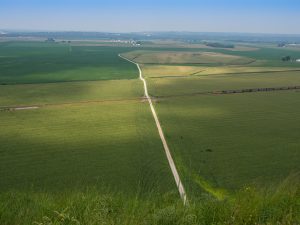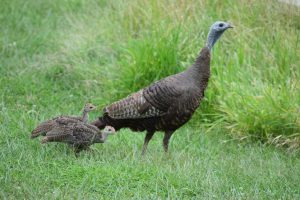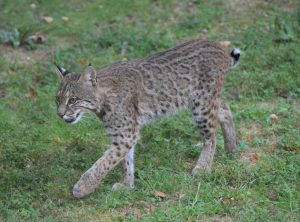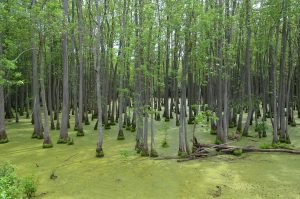Saving Nature in Illinois, The Rewards of Persistence
By William McClain, Illinois Nature Preserves Commissioner
In the year 1805, federal land surveyors travelled to White County to begin dividing the Illinois Territory into townships in preparation for land sales expected in the next few years. They carried surveying tools and camping gear, but one of their most important possessions was a set of instructions, developed by the Surveyor General of the United States, that defined the requirements of their work. Notes and maps, showing the vegetation, streams, lakes and ponds, and other natural features, had to be prepared for each township, an area totaling 36 square miles. These surveys would end, 50 years later, in the northern part of the state.
The maps produced would be used, at later dates, to determine acreages of forest and prairie within Illinois, a state with a land surface of 37 million acres. It was determined that tallgrass prairie was the most common vegetation type, covering 22 million acres, especially in the northern part of the state. It was this feature that caused Illinois to be known as the “Prairie state”.
The remaining 15 million acres was forest, ranging from cypress-tupelo swamps along the Cache River in southern Illinois, to post oak flatwoods on the southern till plain, and oak-hickory forests on the uplands and stream bottoms of the north. Individual tree sizes within the old-growth forests were impressive because many individuals ranged from four to six feet in diameter. However, the most spectacular forests were those located in the Wabash River bottoms near present day Mt. Carmel. The elms, sweet gums, sycamores, and oaks here were of a size unequaled anywhere outside of the tropics. The forest canopy, which rose to 100 feet, was interrupted now and then by an exceptionally tall sweet gum, oak, or sycamore. One sycamore, determined to be 160 feet in height and fifteen feet in diameter, was the largest tree east of the Rocky Mountains.
There was another vegetation type that received far less publicity than prairies and forests. These were the wetlands, called swamplands by surveyors, whose 1,229,720 acres were often combined with prairie or forest. Wet prairies were present at the Inlet and Great Winnebago Swamps along the Green River, the Grand Kankakee Marsh of the Kankakee River while forested wetlands, like Big and Little Black Sloughs, occurred along the Cache River of Southern Illinois.
Early travelers wrote about the vast prairies and majestic forests, but one impressive feature of the territory was the wildlife. Father Marquette, a French explorer in 1693, said: “the Illinois country (prairie) is alive with buffalo, snorting, wading, and winding their way, sometimes in single-file, across the landscape” to water, salt licks, or wallowing sites. Elk and unimaginable numbers of prairie chickens inhabited the prairies, huge flocks of passenger pigeons flew overhead for hours, and waterfowl covered the sky from horizon to horizon during migrations. Birds and insects in vast numbers inhabited the prairies, and songbirds, wolves, bears, and cougars roamed the forests. It was a spectacle beyond belief for those yet to visit the prairie state.
These wildlife populations remained relatively stable throughout much of the 1700’s, a time of sparse European settlement. Hunting parties from the French communities at Peoria, Kaskaskia, and Prairie du Rocher set out in search of bison, beaver, and deer for the growing fur industry. Some noticed a decline of bison by the 1790’s. Wolves, mountain lions, and bears, all considered threats to humans and livestock, were shot for meat or bounties. Wolves, held in special disdain, were described by Morris Birkbeck, in a speech to the legislature in 1823, as the single greatest obstacle to the growth of Illinois. Bounty systems were enacted and wolves declined in numbers during the 1800’s.

A train rolls through the Mississippi River bottoms in Monroe County. Photo courtesy Tom Rollins, Thomas Rollins Photography
The arrival of immigrants increased after Illinois became a state in 1818, but the clearing of forests and cultivation of prairies proceeded slowly. It took the construction of railroads in the 1850’s to create lasting impacts upon the land. They required immense amounts of wood for fuel, buildings, bridges, trestles, and ties. Illinois, in 1850, had virtually no railroads, but 10,000 miles of track were in place by the year 1900. Each mile required 3,000 oak ties, the equivalent of six acres of forest. Original forests disappeared, causing Charles Parks, a professor at Blackburn College in Carlinville, to state: “It was the (Alton & Sangamon) Railroad that removed the original oak forest from the (Macoupin) County.”
Most settlers had favorable views of railroads. Pioneers were here to make the land productive, not to live in harmony with nature. Railroads provided farmers with fast and economical transportation for shipping grain and livestock to markets, but they also brought more immigrants and farm equipment, hastening the cultivation of prairies and clearing of forests. They also proved to be a boon to another group of men, the market hunters, those that made a living selling wild game. Prairie chickens, ducks, or wild turkeys could be killed, packed, and shipped to a big city and served on restaurant tables that evening.
Railroad personnel were keenly aware of the financial gains to be made from the plentiful wildlife, causing them to develop schedules describing hunting opportunities at sites along their routes. Some lines offered to carry the dogs for free, an incentive more than adequate to entice thousands of hunters to ride the rails with their guns, ammunition, and dogs to sites like the Grand Kankakee Marsh. Hunters that started with 500 shells one morning often found themselves completely out of ammunition before the end of the second day.

Wild turkeys were extirpated in Illinois, but have made an amazing comeback. Photo courtesy Mike Fricke.
Prairie chicken hunting in Illinois was widely known, causing the Prince of Wales to come by special train to Ford County in 1860 to hunt these birds. The years following the Civil War witnessed increased cultivation of native grasslands, but prairie chickens thrived due to the combination of grassland for nesting and roosting and fields of corn for food. However, this population boom was short-lived when farmers realized the extent of the depredations on their corn crops left standing in the fields. They retaliated by burning prairies in May when hens were nesting, killing adult birds and their eggs. It was this practice, combined with habitat loss and unrestricted hunting, that reduced prairie chickens to scattered populations by the 1900’s. Eventually, only a few small flocks remained in a few Southern Illinois counties where redtop grass served as a substitute for native prairie.

Bobcats were also extirpated in the Prairie State, but are seen more frequently throughout the state now, including Monroe County. Photo courtesy Joann Fricke
The 20th century was a time when several influential people reflected on the biological diversity that had been lost from the Prairie State. Only two thousand acres of native prairie, once the dominant land cover, remained out of the original 22 million. Forests had been severely cleared and logged, resulting in isolated patches totaling about seven million acres statewide. Nearly all of the wetlands, comprising over 1,229,000 acres, had been drained. Bald eagles, wild turkeys, whitetail deer, elk, bison, bears, cougars, wolves, bobcats, beavers, and river otters were extirpated and passenger pigeons and Carolina parakeets were extinct.
What could be done? Habitat loss, fragmentation, and invasive species were known to be among the forces driving the decline of natural communities. Groups began by improving remnants and creating new habitat for the benefit of the remaining plants and animals. Various sites were identified for grassland dependent species, including Lost Mound in Jo Daviess County, Kankakee Sands in Iroquois County, Mediwin National Tallgrass Prairie in Will County, Nachussa Grasslands in Ogle County, and Prairie Ridge State Natural Area in Jasper County. They would all prove to be ideal areas for grasshopper sparrows, bobolinks, eastern and western meadowlarks, loggerhead shrikes, dickcissels, short-eared owls, and northern harriers, prairie chickens, and other grassland plants and animals.

Cypress-tupelo swamp on the Cache River. Photo courtesy Chris Benda.
Former wetlands drained over a century ago were identified for restoration. Emiquon, also known as Thompson Lake, near Havana on the Illinois River, is currently managed to benefit wetland plants, waterfowl, and wading birds. Cypress/tupelo swamps along the Cache River, drained by the effects of the Post Creek cutoff, are being restored. Waterfowl, prothonatary warblers, amphibians, reptiles, and an assortment of plant life have benefited.
Deer, river otters, and wild turkeys have increased dramatically since they were reintroduced in the last century. None of these were present during my childhood, but I remember dad taking my brothers and me to a farm to see a deer that was staying with a herd of cattle. It was a majestic buck, and I remember thinking the deer surely must be lonely if he is staying with a bunch of cows.
Bison, after an absence from Illinois of 150 years, were re-introduced at Mediwin National Tallgrass Prairie and Nachusa Grasslands. These animals, due to their grazing and wallowing, create a diversity of habitats suitable for birds and certain plants. A herd of 125 animals currently reside at Nachusa, and numerous calves have been born since their re-introduction.
Bobcats and beavers were also very rare in my childhood days. Our grandad took us to a creek and cautioned us to be very still and quiet. It wasn’t long before a beaver swam by on its way to the dam they had built on the small stream. It was the first beaver my brothers and I had seen, but they have since become common throughout the state.
Bald eagles were absent from Illinois for over a century until about 40 years ago when a few pairs nested in the state. Their numbers have increased in the ensuing years, and they now nest in many counties within the state. Recently, I had the opportunity to view a sight likely not seen in Macoupin County for well over a century. Two mature bald eagles were sitting on utility poles adjacent to the highway east of town.
One of the most encouraging and significant developments over the last sixty years has been the formation of numerous conservation groups and the increasing role of volunteers. There are few parts of the state that do not have one or more groups. Most have a local or regional focus, but all are involved in preserving, restoring, and creating communities of plants and animals. Their work has made multitudes keenly aware of another fact; if you want to keep nature, it takes work. Their efforts are proving that progress can be made in bringing nature back to the Prairie State.
Author bio: William McClain is the former Natural Areas Stewardship Program Manager for the Illinois Department of Natural Resources’ Division of Natural Heritage. He is an Adjunct Research Associate in Botany at the Illinois State Museum and a member of the Illinois Nature Preserves Commission.
This article was originally published in the Summer 2018 issue of Illinois Audubon magazine. It is reprinted here with the permission of the author and the magazine.
CLIFFTOP, a local nonprofit organization, is focused on preserving and protecting area blufflands.
A version of this article appeared in the October 5, 2018 edition of the Monroe County Independent.
©2018 all content rights reserved Clifftop NFP
Comments are currently closed.
